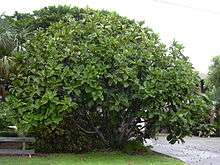Ficus lyrata
| Ficus lyrata | |
|---|---|
 | |
| Scientific classification | |
| Kingdom: | Plantae |
| (unranked): | Angiosperms |
| (unranked): | Eudicots |
| (unranked): | Rosids |
| Order: | Rosales |
| Family: | Moraceae |
| Genus: | Ficus |
| Subgenus: | Urostigma |
| Species: | F. lyrata |
| Binomial name | |
| Ficus lyrata Warb. | |
Ficus lyrata, commonly known as the fiddle-leaf fig, is a species of flowering plant in the mulberry and fig family Moraceae. It is native to western Africa, from Cameroon west to Sierra Leone, where it grows in lowland tropical rainforest.
It is a banyan fig (Ficus subgenus Urostigma) that commonly starts life as an epiphyte high in the crown of another tree; it then sends roots down to the ground which envelop the trunk of the host tree and slowly strangle it. It can also grow as a free-standing tree on its own, growing up to 12–15 m (39–49 ft) tall.
The leaves are variable in shape, but often with a broad apex and narrow middle, resembling a lyre or fiddle; they are up to 45 cm (18 in) long and 30 cm (12 in) broad, though usually smaller, with a leathery texture, prominent veins and a wavy margin.
The fruit is a green fig 2.5-3 cm (1-¼ in) diameter.
Cultivation and garden uses
It is a popular ornamental tree in subtropical and tropical gardens, and is also grown as a houseplant in temperate areas, where it usually stays shorter and fails to flower or fruit. Like most figs, it is frost tender.
This plant has gained the Royal Horticultural Society's Award of Garden Merit.[1]
References
- ↑ "Ficus lyrata AGM". Royal Horticultural Society. Retrieved 27 July 2013.
External links
- Figweb: Ficus lyrata
- Huxley, A., ed. (1992). New RHS Dictionary of Gardening. Macmillan.
- Dressler, S.; Schmidt, M. & Zizka, G. (2014). "Ficus lyrata". African plants – a Photo Guide. Frankfurt/Main: Forschungsinstitut Senckenberg.